Urban Land Carbon Emission and Carbon Emission Intensity Prediction Based on Patch-Generating Land Use Simulation Model and Grid with Multiple Scenarios in Tianjin
Abstract
:1. Introduction
2. Materials and Methods
2.1. Overview of the Research Area
2.2. Research Data Sources
2.3. Research Methods
2.3.1. Research Framework
2.3.2. PLUS Model
- Markov module
- 2.
- PLUS model
2.3.3. Estimation of Carbon Emissions from Land Use
- Direct carbon emission estimation
- 2.
- Indirect carbon emission estimation
- 3.
- Grid-based estimation of carbon emission intensity
- 4.
- Carbon Emission Forecast for 2030
3. Experimental Results
3.1. Spatiotemporal Analysis of Land Use
3.1.1. Analysis of Land Use Time
3.1.2. Spatial and Temporal Analysis of Land Use in 2030
3.2. Spatiotemporal Analysis of Carbon Emissions
3.2.1. Direct Carbon Emission Time Analysis
3.2.2. Indirect Carbon Emissions
3.2.3. Distribution of Total Carbon Emissions and Carbon Emission Intensity
3.2.4. Analysis of Carbon Emission Intensity Zoning
3.2.5. Spatial Autocorrelation Analysis of Carbon Emission Density
4. Discussion
4.1. Land Use Change and Carbon Emissions
4.2. The Relationship between Construction Land Expansion and Carbon Emission Intensity
4.3. Shortcomings and Prospects
4.4. Policy Recommendations
5. Conclusions
Author Contributions
Funding
Data Availability Statement
Conflicts of Interest
References
- Avotra, A.A.R.N.; Nawaz, A. Asymmetric impact of transportation on carbon emissions influencing SDGs of climate change. Chemosphere 2023, 324, 138301. [Google Scholar] [CrossRef]
- Jiang, J.; Xie, D.; Ye, B.; Shen, B.; Chen, Z. Research on China’s cap-and-trade carbon emission trading scheme: Overview and outlook. Appl. Energy 2016, 178, 902–917. [Google Scholar] [CrossRef]
- Meng, Z.; Wang, H.; Wang, B. Empirical Analysis of Carbon Emission Accounting and Influencing Factors of Energy Consumption in China. Int. J. Environ. Res. Public Health 2018, 15, 2467. [Google Scholar] [CrossRef]
- Li, J.; Jiao, L.; Li, F.; Lu, X.; Hou, J.; Li, R.; Cai, D. Spatial disequilibrium and influencing factors of carbon emission intensity of construction land in China. J. Clean. Prod. 2023, 396, 136464. [Google Scholar] [CrossRef]
- Liu, C.; Cheng, L.; Li, J.; Lu, X.; Xu, Y.; Yang, Q. Trade-offs analysis of land use functions in a hilly-mountainous city of northwest Hubei Province: The interactive effects of urbanization and ecological construction. Habitat Int. 2023, 131, 102705. [Google Scholar] [CrossRef]
- Wang, M.; Wang, Y.; Wu, Y.; Yue, X.; Wang, M.; Hu, P. Identifying the spatial heterogeneity in the effects of the construction land scale on carbon emissions: Case study of the Yangtze River Economic Belt, China. Environ. Res. 2022, 212, 113397. [Google Scholar] [CrossRef]
- Wu, H.; Deng, K.; Dong, Z.; Meng, X.; Zhang, L.; Jiang, S.; Yang, L.; Xu, Y. Comprehensive assessment of land use carbon emissions of a coal resource-based city, China. J. Clean. Prod. 2022, 379, 134706. [Google Scholar] [CrossRef]
- Cai, C.; Fan, M.; Yao, J.; Zhou, L.; Wang, Y.; Liang, X.; Liu, Z.; Chen, S. Spatial-temporal characteristics of carbon emissions corrected by socio-economic driving factors under land use changes in Sichuan Province, southwestern China. Ecol. Inform. 2023, 77, 102164. [Google Scholar] [CrossRef]
- Ke, Y.; Xia, L.; Huang, Y.; Li, S.; Zhang, Y.; Liang, S.; Yang, Z. The carbon emissions related to the land-use changes from 2000 to 2015 in Shenzhen, China: Implication for exploring low-carbon development in megacities. J. Environ. Manag. 2022, 319, 115660. [Google Scholar] [CrossRef] [PubMed]
- Hong, T.; Huang, X.; Zhang, X.; Deng, X. Correlation modelling between land surface temperatures and urban carbon emissions using multi-source remote sensing data: A case study. Phys. Chem. Earth Parts A/B/C 2023, 132, 103489. [Google Scholar] [CrossRef]
- Wang, Q.; Yang, C.-h.; Wang, M.-l.; Zhao, L.; Zhao, Y.-c.; Zhang, Q.-p.; Zhang, C.-y. Decoupling analysis to assess the impact of land use patterns on carbon emissions: A case study in the Yellow River Delta efficient eco-economic zone, China. J. Clean. Prod. 2023, 412, 137415. [Google Scholar] [CrossRef]
- Fu, W.; Yang, S.; Hu, S.; Zhang, P. The impact of embodied land flow in interregional trade on carbon emissions in China. Appl. Geogr. 2023, 159, 103065. [Google Scholar] [CrossRef]
- Wei, B.; Kasimu, A.; Reheman, R.; Zhang, X.; Zhao, Y.; Aizizi, Y.; Liang, H. Spatiotemporal characteristics and prediction of carbon emissions/absorption from land use change in the urban agglomeration on the northern slope of the Tianshan Mountains. Ecol. Indic. 2023, 151, 110329. [Google Scholar] [CrossRef]
- Feudjio Fogang, L.; Tiomo, I.F.; Kamga, B.Y.; Mounmemi Kpoumie, H.; Tanougong Nkondjoua, A.D.; Nguetsop, V.F.; Zapfack, L. Predicting land use/land cover changes in the Santchou Wildlife Reserve (Santchou, West-Cameroon) using a CA-Markov model. Trees For. People 2023, 14, 100438. [Google Scholar] [CrossRef]
- Ghadirian, O.; Lotfi, A.; Moradi, H.; Shetab Boushehri, S.N.; Yousefpour, R. Area-based scenario development in land-use change modeling: A system dynamics-assisted approach for mixed agricultural-residential landscapes. Ecol. Inform. 2023, 76, 102129. [Google Scholar] [CrossRef]
- Molinero-Parejo, R.; Aguilera-Benavente, F.; Gómez-Delgado, M.; Shurupov, N. Combining a land parcel cellular automata (LP-CA) model with participatory approaches in the simulation of disruptive future scenarios of urban land use change. Comput. Environ. Urban Syst. 2023, 99, 101895. [Google Scholar] [CrossRef]
- Liang, X.; Guan, Q.; Clarke, K.C.; Liu, S.; Wang, B.; Yao, Y. Understanding the drivers of sustainable land expansion using a patch-generating land use simulation (PLUS) model: A case study in Wuhan, China. Comput. Environ. Urban Syst. 2021, 85, 101569. [Google Scholar] [CrossRef]
- Luo, H.; Li, Y.; Gao, X.; Meng, X.; Yang, X.; Yan, J. Carbon emission prediction model of prefecture-level administrative region: A land-use-based case study of Xi’an city, China. Appl. Energy 2023, 348, 121488. [Google Scholar] [CrossRef]
- Rong, T.; Zhang, P.; Li, G.; Wang, Q.; Zheng, H.; Chang, Y.; Zhang, Y. Spatial correlation evolution and prediction scenario of land use carbon emissions in the Yellow River Basin. Ecol. Indic. 2023, 154, 110701. [Google Scholar] [CrossRef]
- Rong, T.; Zhang, P.; Zhu, H.; Jiang, L.; Li, Y.; Liu, Z. Spatial correlation evolution and prediction scenario of land use carbon emissions in China. Ecol. Inform. 2022, 71, 101802. [Google Scholar] [CrossRef]
- Plevin, R.J.; Jones, J.; Kyle, P.; Levy, A.W.; Shell, M.J.; Tanner, D.J. Choices in land representation materially affect modeled biofuel carbon intensity estimates. J. Clean. Prod. 2022, 349, 131477. [Google Scholar] [CrossRef] [PubMed]
- Gui, D.; He, H.; Liu, C.; Han, S. Spatio-temporal dynamic evolution of carbon emissions from land use change in Guangdong Province, China, 2000–2020. Ecol. Indic. 2023, 156, 111131. [Google Scholar] [CrossRef]
- Li, W.; Chen, Z.; Li, M.; Zhang, H.; Li, M.; Qiu, X.; Zhou, C. Carbon emission and economic development trade-offs for optimizing land-use allocation in the Yangtze River Delta, China. Ecol. Indic. 2023, 147, 109950. [Google Scholar] [CrossRef]
- The Tianjin Carbon Peak Implementation Plan was recently released. China Chlor-Alkali, 2022; 50.
- Chen, S.; Yao, S. Identifying the drivers of land expansion and evaluating multi-scenario simulation of land use: A case study of Mashan County, China. Ecol. Inform. 2023, 77, 102201. [Google Scholar] [CrossRef]
- Gao, L.; Tao, F.; Liu, R.; Wang, Z.; Leng, H.; Zhou, T. Multi-scenario simulation and ecological risk analysis of land use based on the PLUS model: A case study of Nanjing. Sustain. Cities Soc. 2022, 85, 104055. [Google Scholar] [CrossRef]
- Liu, Y.; Jing, Y.; Han, S. Multi-scenario simulation of land use/land cover change and water yield evaluation coupled with the GMOP-PLUS-InVEST model: A case study of the Nansi Lake Basin in China. Ecol. Indic. 2023, 155, 110926. [Google Scholar] [CrossRef]
- Shi, Q.; Gu, C.-J.; Xiao, C. Multiple scenarios analysis on land use simulation by coupling socioeconomic and ecological sustainability in Shanghai, China. Sustain. Cities Soc. 2023, 95, 104578. [Google Scholar] [CrossRef]
- Li, X.; Fu, J.; Jiang, D.; Lin, G.; Cao, C. Land use optimization in Ningbo City with a coupled GA and PLUS model. J. Clean. Prod. 2022, 375, 134004. [Google Scholar] [CrossRef]
- Wang, M.; Jiang, Z.; Li, T.; Yang, Y.; Jia, Z. Analysis on absolute conflict and relative conflict of land use in Xining metropolitan area under different scenarios in 2030 by PLUS and PFCI. Cities 2023, 137, 104314. [Google Scholar]
- Zhang, Z.; Hu, B.; Jiang, W.; Qiu, H. Spatial and temporal variation and prediction of ecological carrying capacity based on machine learning and PLUS model. Ecol. Indic. 2023, 154, 110611. [Google Scholar] [CrossRef]
- Zhou, Y.; Chen, M.; Tang, Z.; Mei, Z. Urbanization, land use change, and carbon emissions: Quantitative assessments for city-level carbon emissions in Beijing-Tianjin-Hebei region. Sustain. Cities Soc. 2021, 66, 102701. [Google Scholar] [CrossRef]
- Long, H.; Yuan, L.; Yin, Z.; Wu, X. Spatiotemporal of ecosystem service values response to land use/cover change based on geo-informatic Tupu—A case study in Tianjin, China. Ecol. Indic. 2023, 154, 110511. [Google Scholar] [CrossRef]
- Escolano-Moltó, A.; Flecha, S.; Vaquer-Sunyer, R.; Wesselmann, M.; Marbà, N.; Hendriks, I.E. Mediterranean Seagrasses as Carbon Sinks: Methodological and Regional Differences; Copernicus GmbH: Göttingen, Germany, 2021. [Google Scholar]
- Zu-Cong, C.; Guo-Ding, K.; Tsuruta, H.; Mosier, A. Estimate of CH4 Emissions from Year-Round Flooded Rice Fields During Rice Growing Season in China. Pedosphere 2005, 15, 66–71. [Google Scholar]
- Yang, X.; Liu, X. Path analysis and mediating effects of influencing factors of land use carbon emissions in Chang-Zhu-Tan urban agglomeration. Technol. Forecast. Soc. Chang. 2023, 188, 122268. [Google Scholar] [CrossRef]
- Wang, M.; Wang, Y.; Teng, F.; Ji, Y. The spatiotemporal evolution and impact mechanism of energy consumption carbon emissions in China from 2010 to 2020 by integrating multisource remote sensing data. J. Environ. Manag. 2023, 346, 119054. [Google Scholar] [CrossRef] [PubMed]
- Yang, Y.; Wang, H.; Li, X.; Huang, X.; Lyu, X.; Tian, H.; Qu, T. How will ecosystem carbon sequestration contribute to the reduction of regional carbon emissions in the future? analysis based on the MOP-PLUS model framework. Ecol. Indic. 2023, 156, 111156. [Google Scholar] [CrossRef]
- Chen, W.; Gu, T.; Fang, C.; Zeng, J. Global urban low-carbon transitions: Multiscale relationship between urban land and carbon emissions. Environ. Impact Assess. Rev. 2023, 100, 107076. [Google Scholar] [CrossRef]
- Liu, J.; Peng, K.; Zuo, C.; Li, Q. Spatiotemporal variation of land-use carbon emissions and its implications for low carbon and ecological civilization strategies: Evidence from Xiamen-Zhangzhou-Quanzhou metropolitan circle, China. Sustain. Cities Soc. 2022, 86, 104083. [Google Scholar] [CrossRef]
- Wu, H.; Fang, S.; Zhang, C.; Hu, S.; Nan, D.; Yang, Y. Exploring the impact of urban form on urban land use efficiency under low-carbon emission constraints: A case study in China’s Yellow River Basin. J. Environ. Manag. 2022, 311, 114866. [Google Scholar] [CrossRef]
- Guo, Y.; Ren, Z.; Wang, C.; Zhang, P.; Ma, Z.; Hong, S.; Hong, W.; He, X. Spatiotemporal patterns of urban forest carbon sequestration capacity: Implications for urban CO2 emission mitigation during China’s rapid urbanization. Sci. Total Environ. 2024, 912, 168781. [Google Scholar] [CrossRef]
- Song, C.; Yang, J.; Wu, F.; Xiao, X.; Xia, J.; Li, X. Response characteristics and influencing factors of carbon emissions and land surface temperature in Guangdong Province, China. Urban Clim. 2022, 46, 101330. [Google Scholar] [CrossRef]
- Wang, Y.; Fan, H.; Wang, H.; Che, Y.; Wang, J.; Liao, Y.; Lv, S. High-carbon expansion or low-carbon intensive and mixed land-use? Recent observations from megacities in developing countries: A case study of Shanghai, China. J. Environ. Manag. 2023, 348, 119294. [Google Scholar] [CrossRef]
- Zhang, L.; Hu, B.; Zhang, Z.; Liang, G. Research on the spatiotemporal evolution and mechanism of ecosystem service value in the mountain-river-sea transition zone based on “production-living-ecological space”—Taking the Karst-Beibu Gulf in Southwest Guangxi, China as an example. Ecol. Indic. 2023, 148, 109889. [Google Scholar] [CrossRef]
- Xiao, F.; Chen, G.; Jiang, J. The Impact of the Establishment of National New Area on the Migration of Regional Center of Gravity: Taking Tianjin Binhai New Area as an Example. In Proceedings of the 2015 China Urban Planning Annual Conference, Guiyang, China, 19–21 September 2015; p. 11. [Google Scholar]
- Yan, Y.; Huang, J. The role of population agglomeration played in China’s carbon intensity: A city-level analysis. Energy Econ. 2022, 114, 106276. [Google Scholar] [CrossRef]
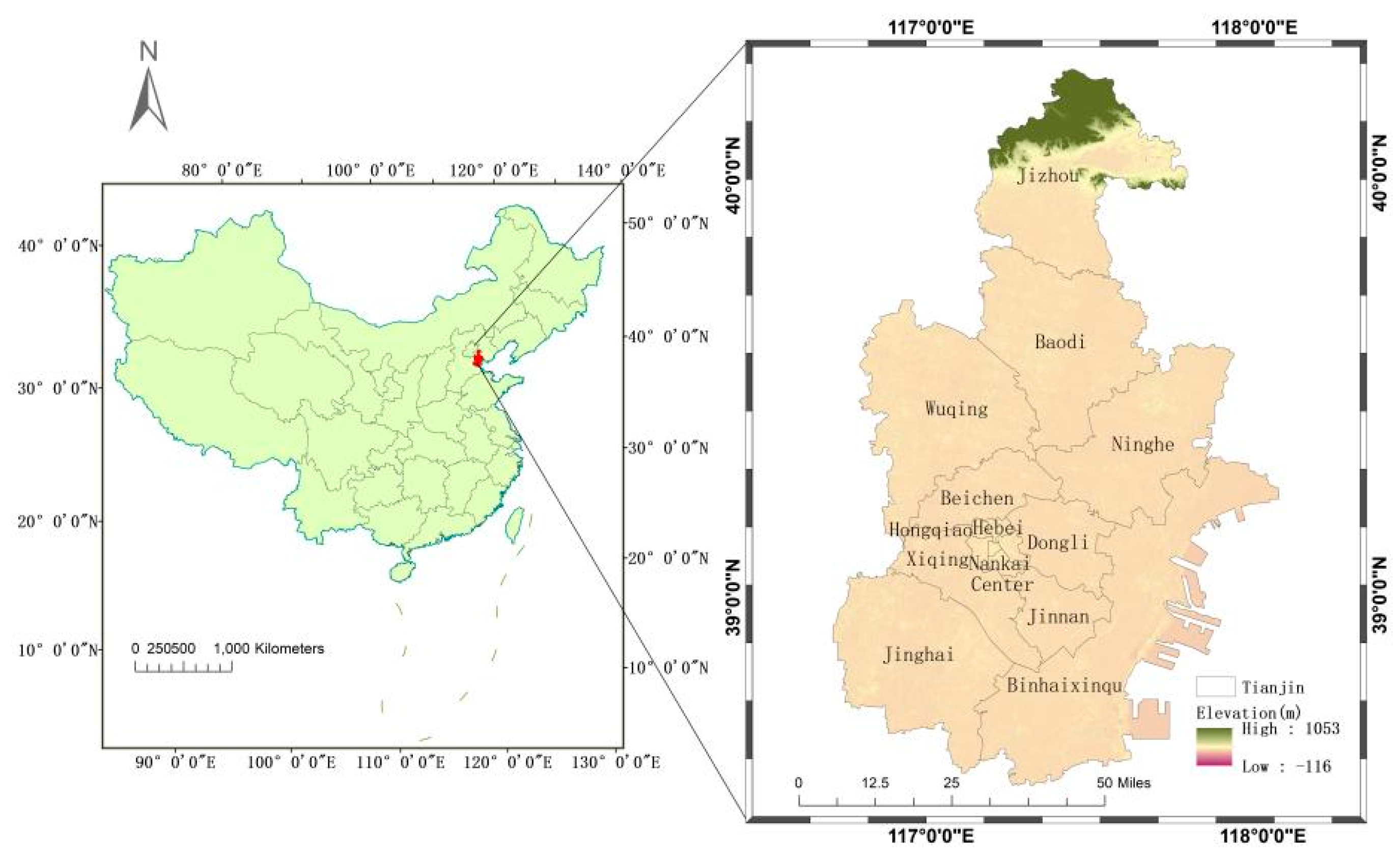
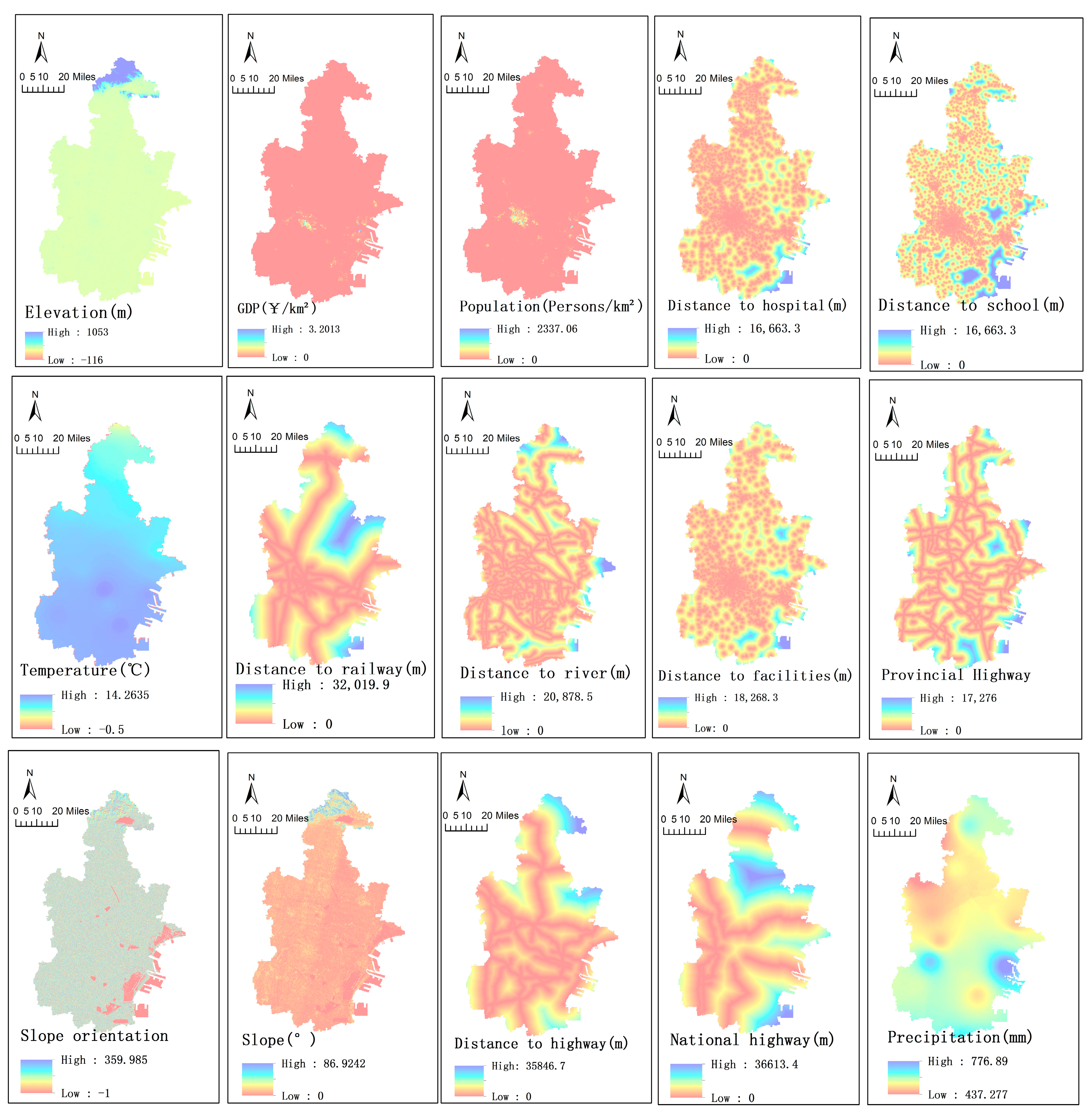


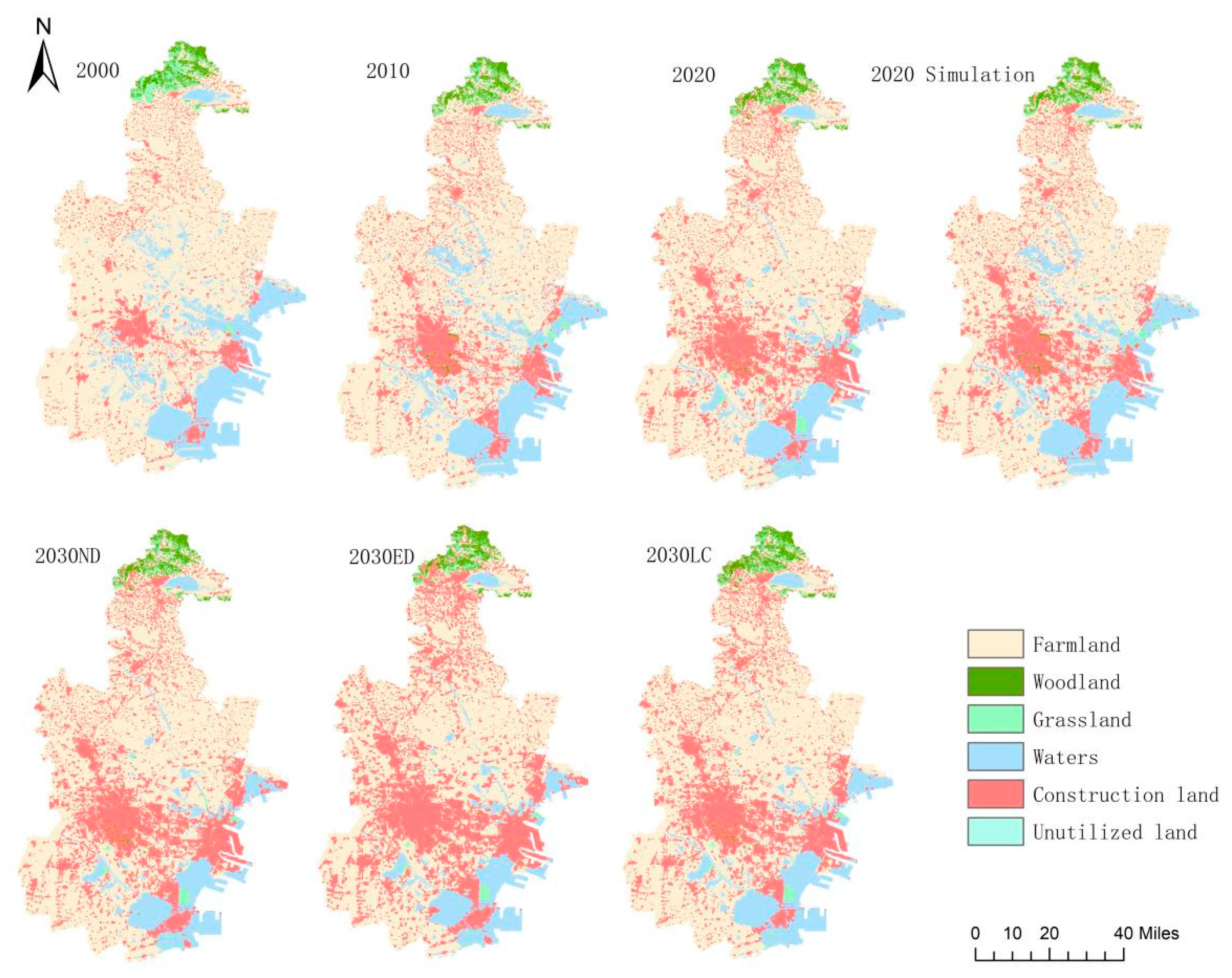

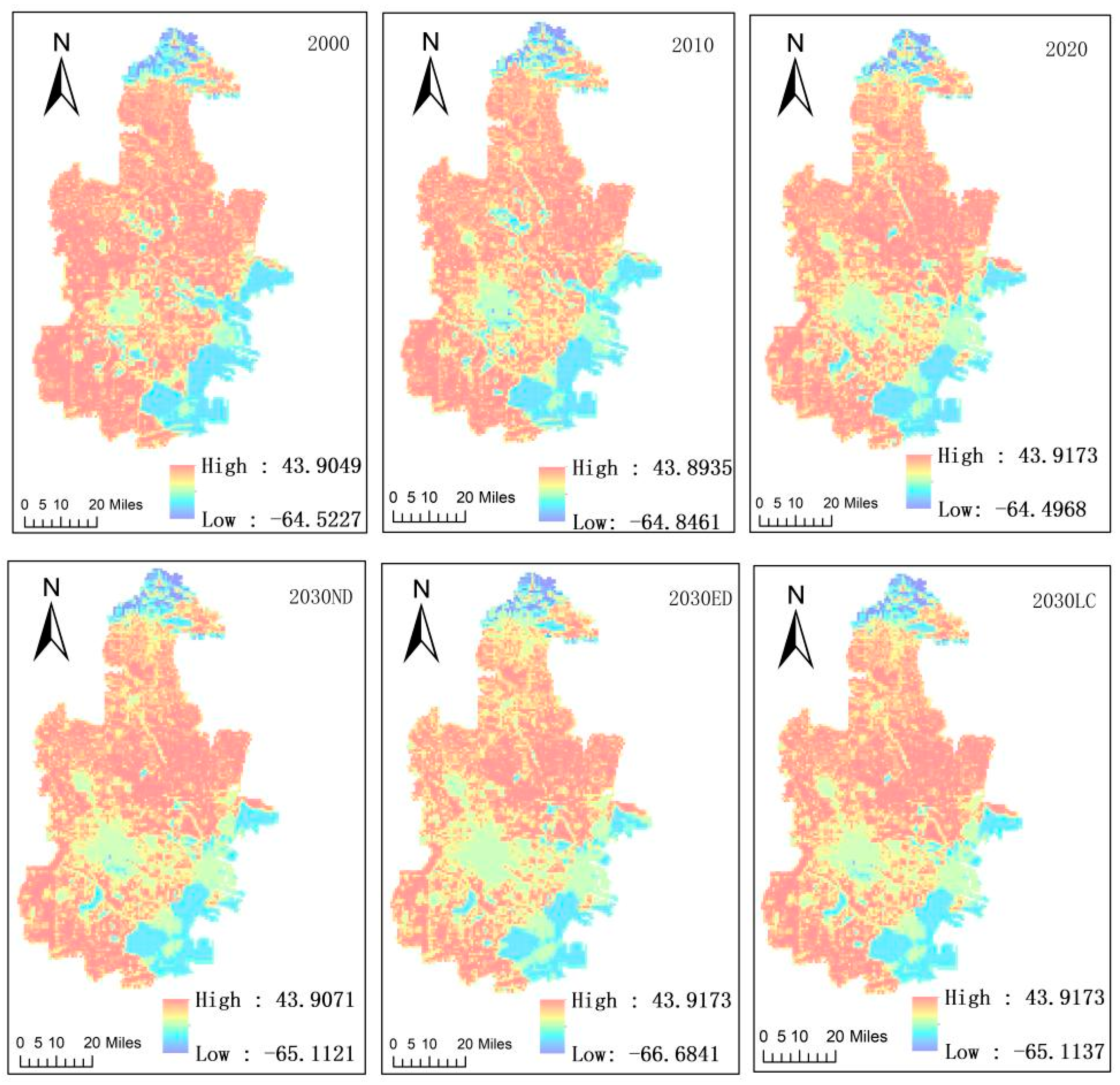

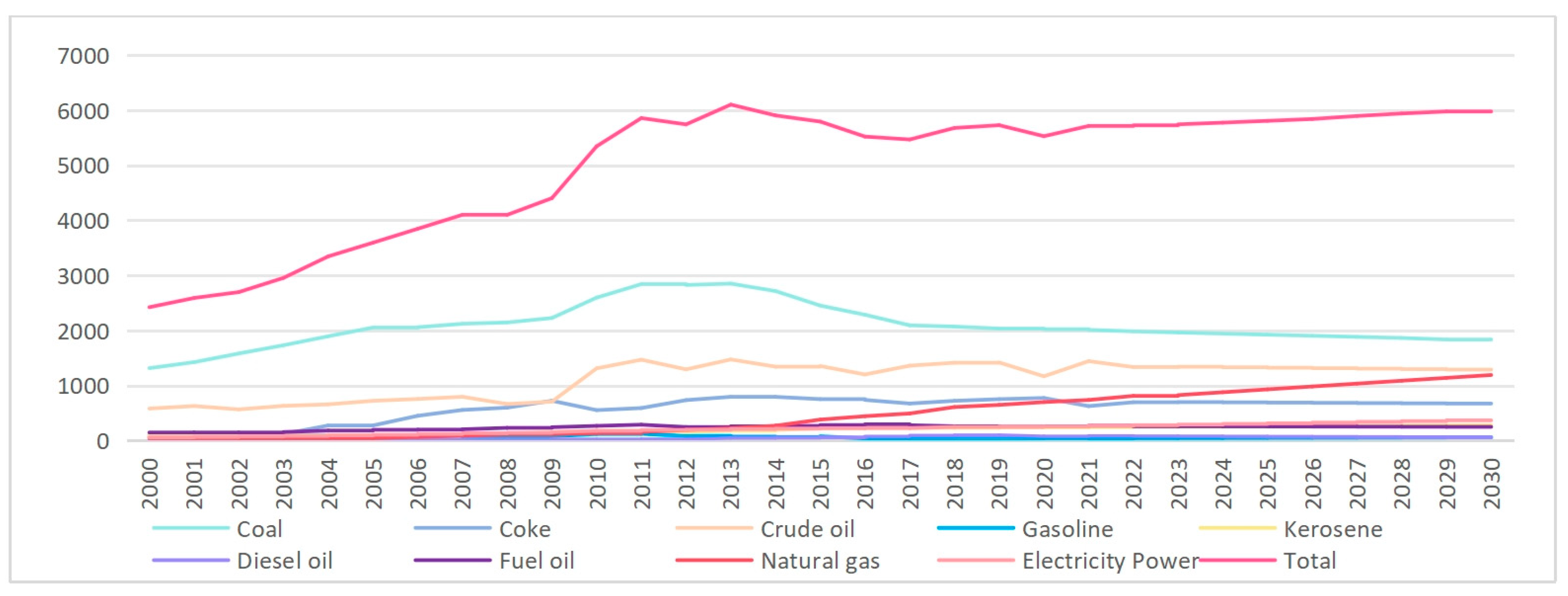
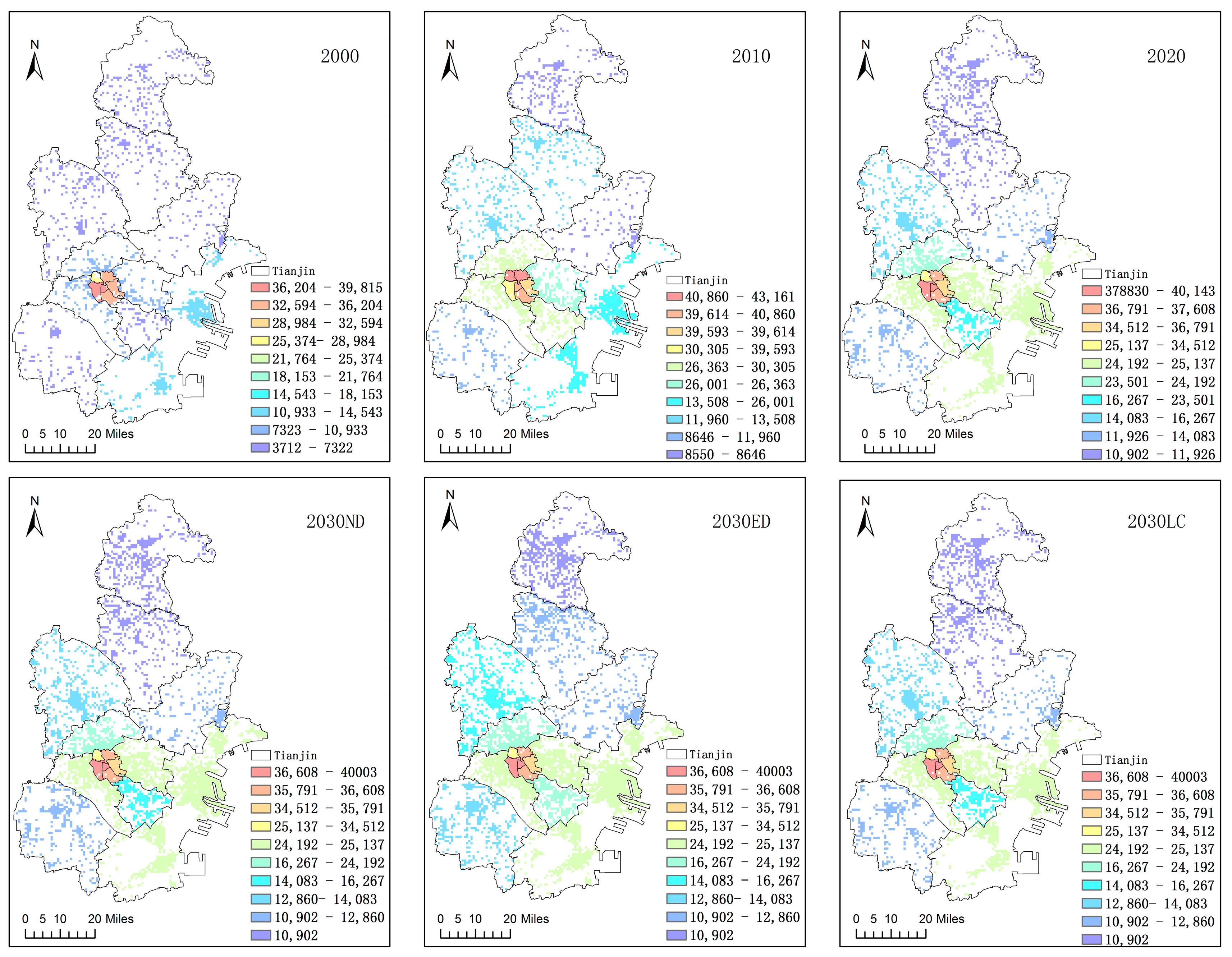
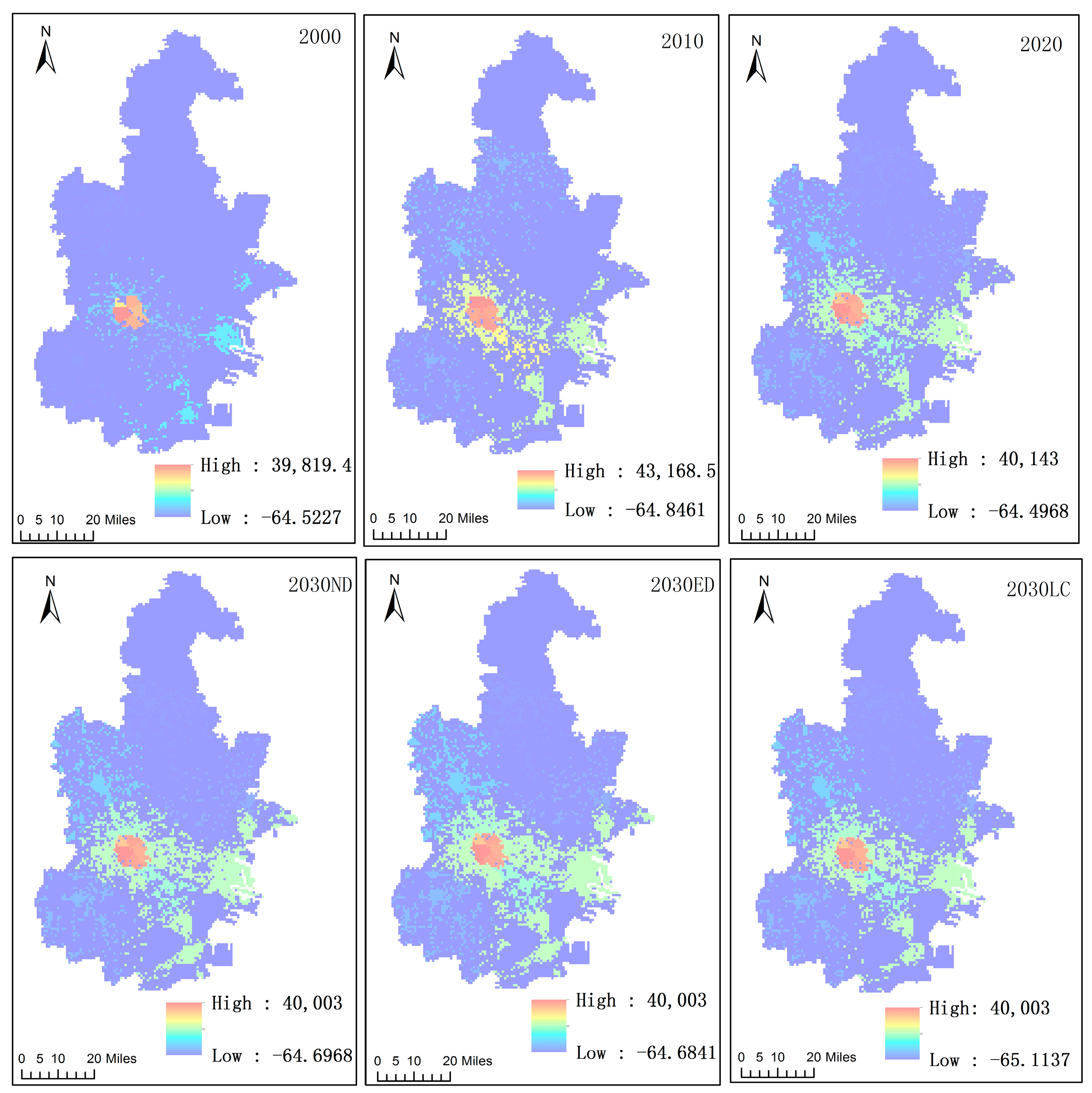

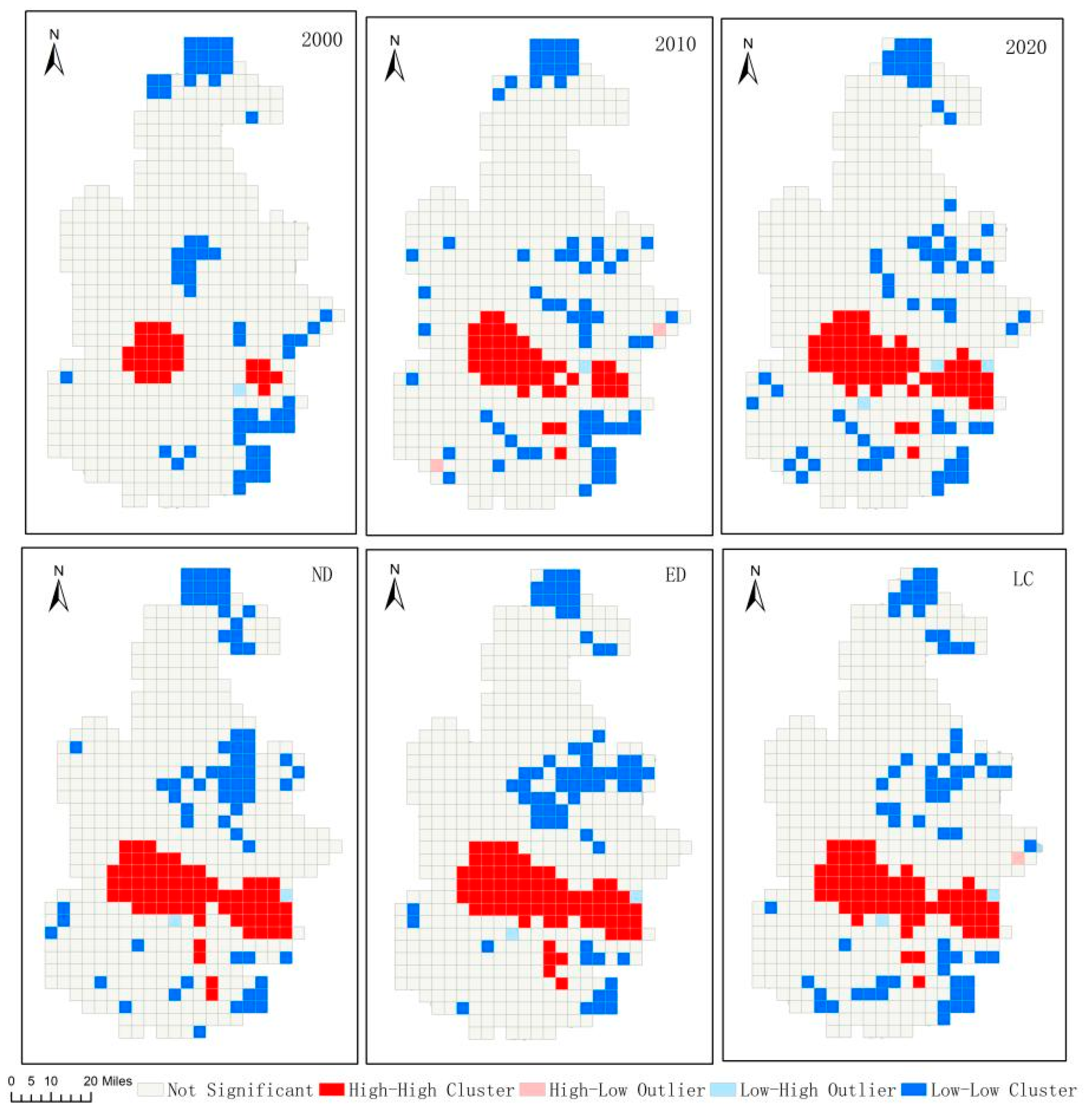
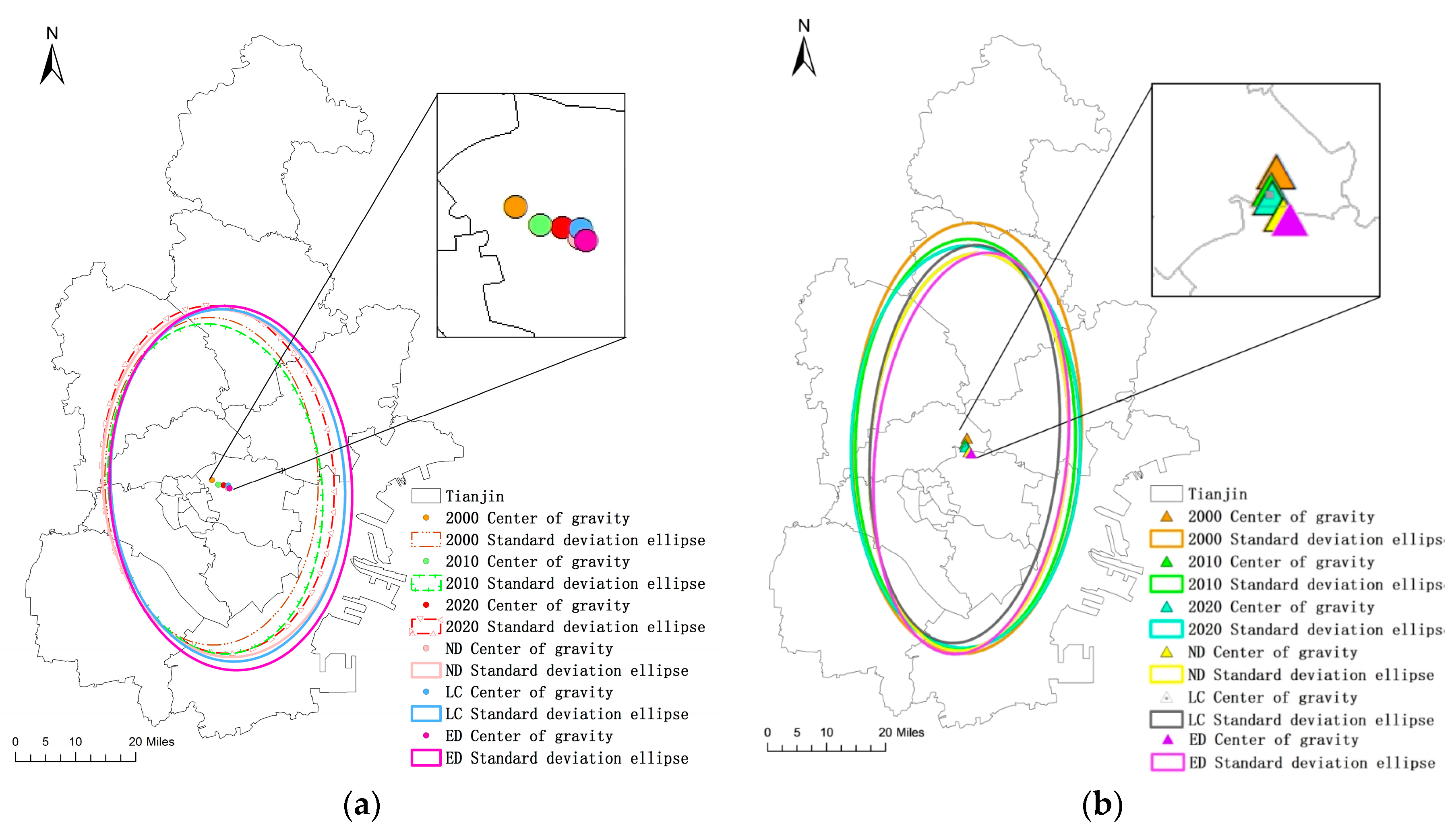
| Data Name | Data Source |
|---|---|
| Land Use DEM, Nighttime Light, Precipitation, Temperature, GDP | RAESADCResource and Environment Science and Data Center (https://www.resdc.cn, accessed on 3 January 2023) |
| Elevation, Slope, Slope Direction | GDC represented by Geospatial Data Cloud (http://www.gscloud.cn) |
| Population Density | Worldpop (https://www.worldpop.org, accessed on 3 January 2023) |
| Distance to Medical Facility Sites, Distance to City Center, Distance to Scientific and Educational Centers, Distance to Railways, Distance to Motorways, Distance to National Highways | ORM represented by Open Road Map database (http://www.openstreetmap.org, accessed on 3 January 2023) calculated using ArcGIS |
| Energy Consumption Data | Government work: Tianjin Statistical Yearbook (https://stats.tj.gov.cn/tjsj_52032/tjnj/, accessed on 3 January 2023) |
| Type of Land | Farmland | Woodland | Grassland | Unutilized Land | Waters | Construction Land |
|---|---|---|---|---|---|---|
| Neighborhood weight | 0.6 | −0.5 | 0.4 | 0.8 | 0.4 | 1 |
| Type of Energy | Conversion Standard Coal Factor (t(C)·t−1) | Carbon Emission Factor (t(C)·t−1) |
|---|---|---|
| Coal | 0.7143 | 0.7559 |
| Coke | 0.9714 | 0.855 |
| Crude oil | 1.4286 | 0.5857 |
| Gasoline | 1.4714 | 0.5538 |
| Kerosene | 1.4714 | 0.5714 |
| Diesel oil | 1.4571 | 0.5921 |
| Fuel oil | 1.286 | 0.6185 |
| Natural gas | 1.33 | 0.4483 |
| Electricity power | 0.1229 | 0.2132 |
| Landscape Type | Farmland | Woodland | Grassland | Construction Land | Unutilized Land | Water |
|---|---|---|---|---|---|---|
| 2000 (km2) | 7988.72 | 204.64 | 266.67 | 1365.21 | 1.11 | 2107.08 |
| 2010 (km2) | 7429.32 | 226.93 | 220.79 | 2032.51 | 1.25 | 2019.66 |
| 2020 (km2) | 7228.81 | 215.90 | 257.16 | 2673.49 | 3.03 | 1543.18 |
| 2030 ED (km2) | 6152.93 | 205.08 | 227.25 | 3990.72 | 2.74 | 1350.96 |
| 2030 ND (km2) | 7001.01 | 214.78 | 262.96 | 3194.40 | 2.94 | 1275.49 |
| 2030 LC (km2) | 6971.84 | 245.46 | 263.51 | 3001.89 | 2.96 | 1435.92 |
| Landscape Type (104 t) | Farmland | Woodland | Grassland | Unutilized Land | Water | Direct |
|---|---|---|---|---|---|---|
| 2000 | 33.71 | −1.32 | −0.06 | −0.07 | 0.00 | 32.27 |
| 2010 | 31.35 | −1.46 | −0.05 | −0.10 | 0.00 | 29.74 |
| 2020 | 30.51 | −1.39 | −0.05 | −0.13 | −0.01 | 28.92 |
| 2030 ND | 29.54 | −1.38 | −0.06 | −0.16 | −0.01 | 27.94 |
| 2030 ED | 25.54 | −1.32 | −0.05 | −0.20 | −0.01 | 23.97 |
| 2030 LC | 29.42 | −1.58 | −0.06 | −0.15 | −0.01 | 27.63 |
| 2000.00 | 2010.00 | 2020.00 | 2030ND | 2030ED | 2030LD | |
|---|---|---|---|---|---|---|
| Direct | 32.27 | 29.74 | 28.92 | 27.94 | 23.97 | 27.63 |
| Indirect | 2421.13 | 5344.75 | 5527.72 | 5984.93 | 6863.29 | 5784.43 |
Disclaimer/Publisher’s Note: The statements, opinions and data contained in all publications are solely those of the individual author(s) and contributor(s) and not of MDPI and/or the editor(s). MDPI and/or the editor(s) disclaim responsibility for any injury to people or property resulting from any ideas, methods, instructions or products referred to in the content. |
© 2023 by the authors. Licensee MDPI, Basel, Switzerland. This article is an open access article distributed under the terms and conditions of the Creative Commons Attribution (CC BY) license (https://creativecommons.org/licenses/by/4.0/).
Share and Cite
Li, X.; Liu, Z.; Li, S.; Li, Y.; Wang, W. Urban Land Carbon Emission and Carbon Emission Intensity Prediction Based on Patch-Generating Land Use Simulation Model and Grid with Multiple Scenarios in Tianjin. Land 2023, 12, 2160. https://doi.org/10.3390/land12122160
Li X, Liu Z, Li S, Li Y, Wang W. Urban Land Carbon Emission and Carbon Emission Intensity Prediction Based on Patch-Generating Land Use Simulation Model and Grid with Multiple Scenarios in Tianjin. Land. 2023; 12(12):2160. https://doi.org/10.3390/land12122160
Chicago/Turabian StyleLi, Xiang, Zhaoshun Liu, Shujie Li, Yingxue Li, and Weiyu Wang. 2023. "Urban Land Carbon Emission and Carbon Emission Intensity Prediction Based on Patch-Generating Land Use Simulation Model and Grid with Multiple Scenarios in Tianjin" Land 12, no. 12: 2160. https://doi.org/10.3390/land12122160
APA StyleLi, X., Liu, Z., Li, S., Li, Y., & Wang, W. (2023). Urban Land Carbon Emission and Carbon Emission Intensity Prediction Based on Patch-Generating Land Use Simulation Model and Grid with Multiple Scenarios in Tianjin. Land, 12(12), 2160. https://doi.org/10.3390/land12122160









